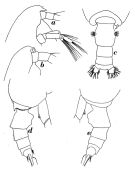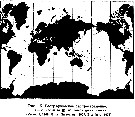|
|
 |
Fiche d'espèce de Copépode |
|
|
Calanoida ( Ordre ) |
|
|
|
Clausocalanoidea ( Superfamille ) |
|
|
|
Aetideidae ( Famille ) |
|
|
|
Pseudochirella ( Genre ) |
|
|
| |
Pseudochirella semispina Vervoort, 1949 (F) | |
| | | | | | | Syn.: | Pseudeuchirella semispina : Björnberg, 1973 (p.325, 388) | | | | Ref.: | | | Vervoort, 1949 (p.44, figs.F); Tanaka & Omori, 1969 a (p.169, Rem.); Bradford & Jillett, 1980 (p.67); Markhaseva, 1989 (p.58); 1996 (p.253) |  Issued from : W. Vervoort in Zool. Verh., Leiden, 1949, 5. [p. 45, Fig.20] Female (from Moluccan Sea): a, forehead (lateral); b, idem (abnormal female); c, urosome (dorsal); d, idem (lateral right side); e, idem (lelt side). Nota: Head and 1st thoracic segment separated, 4th and 5th separated. The abdominal segments and furca in the proportional lengths 44:22:15:8:11 = 100. A1 (24 free segments) reaches the middle of the abdomen. A2: internal lobe of the 2nd endopodal segment with 8 setae, external lobe with 7 setae; the 1st and 2nd endopodal segments are separated.
| | | | | Ref. compl.: | | | Grice & Hulsemann, 1967 (p.15) | | | | NZ: | 3 | | |
|
Carte de distribution de Pseudochirella semispina par zones géographiques
|
| | | | | |  Issued from : E.L. Markhaseva in Issled. Fauny Morei, 1989, 41 (49). [p.58, Fig.15]. Issued from : E.L. Markhaseva in Issled. Fauny Morei, 1989, 41 (49). [p.58, Fig.15].
Geographical distribution of P. semispina from literature. |
| | | | Loc: | | | W Indian, Molucca Sea, Timor Sea , Arafura Sea, Peru | | | | N: | 3 | | | | Lg.: | | | (41) F: 5,85-5,5; {F: 5,50-5,85} | | | | Rem.: | The species resembles P. gibbera and P. notacantha. From the former it differs distinctly by the shape of the abdomen; the latter has the lateral spine on both sides of the lateral thoracic margin (the presence of the right spine only for 4 females of P. semispina is not due to damage).
Markhaseva (1996, p.294) remarks that Tanaka & Omori (1969) noted close connection between this species and P. vervoorti Vervoort, 1949, but distinguished the species in segmentation of P2 endopod (1-segmented in P. semispina vs 2-segmented in P. vervoorti), in highter number of spines on coxopodite of P4 (7-8 in P. semispina vs 9-12 in P. vervoorti), in different proportion of endopod and exopod of A2 (exopod 1.2 times endopod in P. semispina), and in different arrangement of hairs on genital segment. | | | Dernière mise à jour : 30/01/2015 | |
|
|
 Toute utilisation de ce site pour une publication sera mentionnée avec la référence suivante : Toute utilisation de ce site pour une publication sera mentionnée avec la référence suivante :
Razouls C., Desreumaux N., Kouwenberg J. et de Bovée F., 2005-2024. - Biodiversité des Copépodes planctoniques marins (morphologie, répartition géographique et données biologiques). Sorbonne Université, CNRS. Disponible sur http://copepodes.obs-banyuls.fr [Accédé le 23 avril 2024] © copyright 2005-2024 Sorbonne Université, CNRS
|
|
 |
 |





